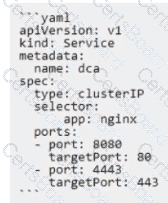Is this the purpose of Docker Content Trust?
Solution: Enable mutual TLS between the Docker client and server.
The Kubernetes yaml shown below describes a clusterIP service.

Is this a correct statement about how this service routes requests?
Solution: Traffic sent to the IP of this service on port 8080 will be routed to port 80 in a random pod with the label aPP: nginx.
Does this command create a swarm service that only listens on port 53 using the UDP protocol?
Solution. ‘docker service create -name dns-cache -p 53:53 -constraint networking.protocol.udp=true dns-cache"
An application image runs in multiple environments, with each environment using different certificates and ports.
Is this a way to provision configuration to containers at runtime?
Solution: Provision a Docker config object for each environment.
You configure a local Docker engine to enforce content trust by setting the environment variable
DOCKER_CONTENT_TRUST=1.
If myorg/myimage: 1.0 is unsigned, does Docker block this command?
Solution: docker service create myorg/myimage:1.0
In Docker Trusted Registry, is this how a user can prevent an image, such as 'nginx:latest’, from being overwritten by another user with push access to the repository?
Solution: Use the DTR web Ul to make all tags in the repository immutable.
Will this command ensure that overlay traffic between service tasks is encrypted?
Solution.docker network create -d overlay --secure
A persistentVolumeClaim (PVC) is created with the specification storageClass: "".and size requirements that cannot be satisfied by any existing persistentVolume.
Is this an action Kubernetes takes in this situation?
Solution: Kubernetes returns an error indicating that the PVC could not be bound with the current resources.
Will This command list all nodes in a swarm cluster from the command line?
Solution. ‘docker swarm nodes'
You add a new user to the engineering organization in DTR.
Will this action grant them read/write access to the engineering/api repository?
Solution. Mirror the engineering/api repository to one of the user's own private repositories.


